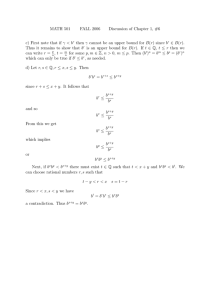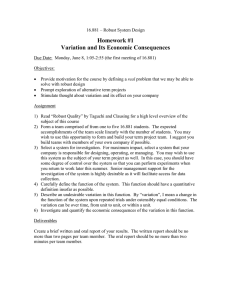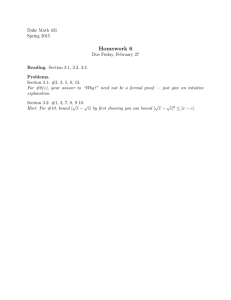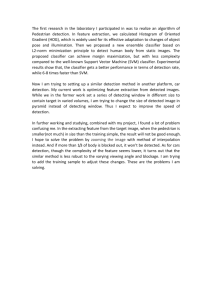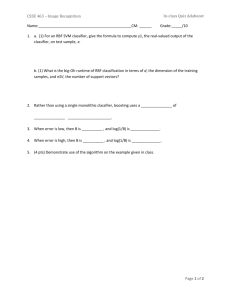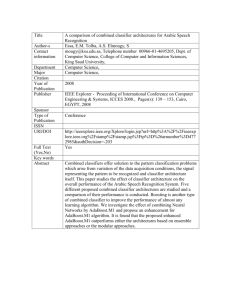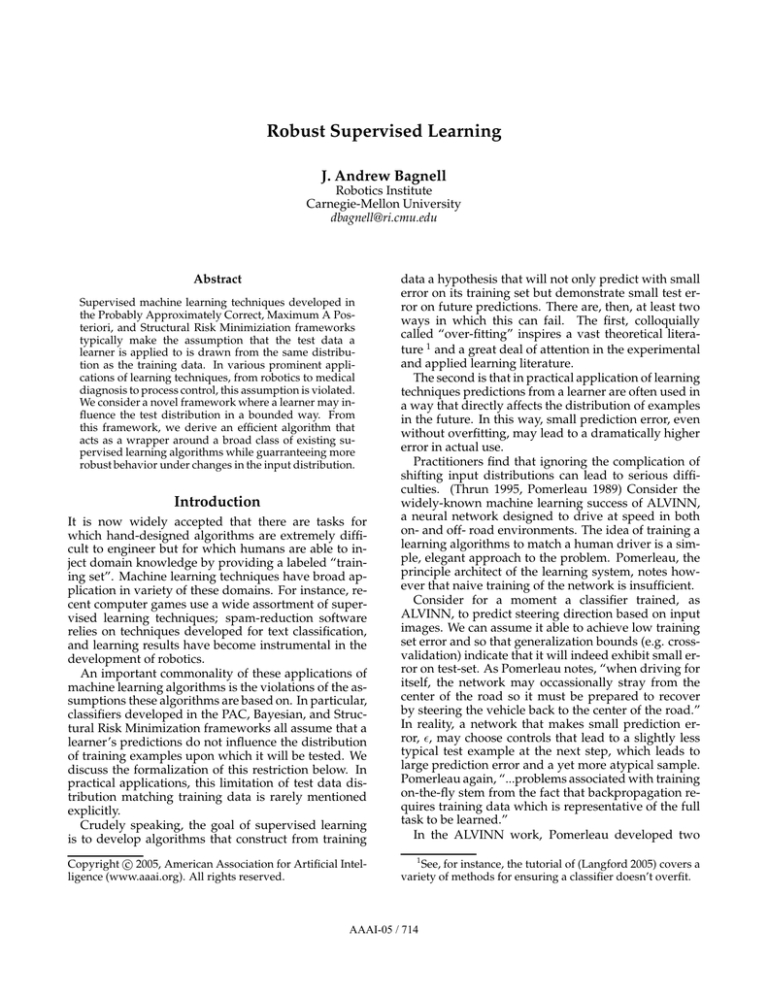
Robust Supervised Learning
J. Andrew Bagnell
Robotics Institute
Carnegie-Mellon University
dbagnell@ri.cmu.edu
Abstract
Supervised machine learning techniques developed in
the Probably Approximately Correct, Maximum A Posteriori, and Structural Risk Minimiziation frameworks
typically make the assumption that the test data a
learner is applied to is drawn from the same distribution as the training data. In various prominent applications of learning techniques, from robotics to medical
diagnosis to process control, this assumption is violated.
We consider a novel framework where a learner may influence the test distribution in a bounded way. From
this framework, we derive an efficient algorithm that
acts as a wrapper around a broad class of existing supervised learning algorithms while guarranteeing more
robust behavior under changes in the input distribution.
Introduction
It is now widely accepted that there are tasks for
which hand-designed algorithms are extremely difficult to engineer but for which humans are able to inject domain knowledge by providing a labeled “training set”. Machine learning techniques have broad application in variety of these domains. For instance, recent computer games use a wide assortment of supervised learning techniques; spam-reduction software
relies on techniques developed for text classification,
and learning results have become instrumental in the
development of robotics.
An important commonality of these applications of
machine learning algorithms is the violations of the assumptions these algorithms are based on. In particular,
classifiers developed in the PAC, Bayesian, and Structural Risk Minimization frameworks all assume that a
learner’s predictions do not influence the distribution
of training examples upon which it will be tested. We
discuss the formalization of this restriction below. In
practical applications, this limitation of test data distribution matching training data is rarely mentioned
explicitly.
Crudely speaking, the goal of supervised learning
is to develop algorithms that construct from training
c 2005, American Association for Artificial IntelCopyright ligence (www.aaai.org). All rights reserved.
data a hypothesis that will not only predict with small
error on its training set but demonstrate small test error on future predictions. There are, then, at least two
ways in which this can fail. The first, colloquially
called “over-fitting” inspires a vast theoretical literature 1 and a great deal of attention in the experimental
and applied learning literature.
The second is that in practical application of learning
techniques predictions from a learner are often used in
a way that directly affects the distribution of examples
in the future. In this way, small prediction error, even
without overfitting, may lead to a dramatically higher
error in actual use.
Practitioners find that ignoring the complication of
shifting input distributions can lead to serious difficulties. (Thrun 1995, Pomerleau 1989) Consider the
widely-known machine learning success of ALVINN,
a neural network designed to drive at speed in both
on- and off- road environments. The idea of training a
learning algorithms to match a human driver is a simple, elegant approach to the problem. Pomerleau, the
principle architect of the learning system, notes however that naive training of the network is insufficient.
Consider for a moment a classifier trained, as
ALVINN, to predict steering direction based on input
images. We can assume it able to achieve low training
set error and so that generalization bounds (e.g. crossvalidation) indicate that it will indeed exhibit small error on test-set. As Pomerleau notes, “when driving for
itself, the network may occassionally stray from the
center of the road so it must be prepared to recover
by steering the vehicle back to the center of the road.”
In reality, a network that makes small prediction error, ǫ, may choose controls that lead to a slightly less
typical test example at the next step, which leads to
large prediction error and a yet more atypical sample.
Pomerleau again, “...problems associated with training
on-the-fly stem from the fact that backpropagation requires training data which is representative of the full
task to be learned.”
In the ALVINN work, Pomerleau developed two
1
See, for instance, the tutorial of (Langford 2005) covers a
variety of methods for ensuring a classifier doesn’t overfit.
AAAI-05 / 714
techniques that explicitly deal with the test-train mismatch. First, Pomerleau develops a system that generated extra training data that effectively emphasizes
some of the harder cases ((Pomerleau 1989), section
3.2). 2 Second, Pomerleau ((Pomerleau 1989), section
3.4) uses a buffer to increase training on examples that
prove more difficult for the learner.
The techniques described in (Pomerleau 1989) are
rather domain-specific, but nevertheless, get to the
essence of an important problem. In this work, we provide a specific formalization of the problem of shifting test-set distributions and derive a general algorithm reminiscent of Pomerleau’s heuristic that optimally solves the formulation. This formulation allows
us to find an optimal solution efficiently and derive
meaningful generalization bounds that hold out-ofsample.
Related Work
There are important frameworks that address issues of
learners that effect the input distribution. In Reinforcement Learning, we are explicitly interested in agents
whose actions affect the world. Recent research in this
field can be understood as explicitly trying to control
the relationship between test and train distributions.
(See for instance, (Bagnell et al. 2003) and (Fern et al.
2003)). Here we address the fundamentally simpler supervised learning problem where correct outputs are
given to us as part of the training set.
The online learning model (Littlestone and Warmuth 1989) makes no assumptions about a distribution
of inputs. It trades this for making no predictive statements, but instead considering performance in retrospect. Predictive results can be established for many
online algorithms but typically make the explicit assumption that the classifier has no effect on the test instances.
One of the closest related works is (Daliv et al. 2004)
where a game between a learner an agent that can affect the training examples is described. In (Daliv et al.
2004), there are more general costs and an adversary
can affect different features on instances in the data set.
Our framework applies instead to the input distribution (and later in the work p(y|x) as well) as opposed
to specific examples. It also presents a game that is
amenable to efficient optimization algorithms and can
make predictive statements.
Robust Learning Framework
In general it is very difficult to predict the changes a
classifier will induce on the test-set distribution. It is
often reasonable, however, to assume at the outset that
the change will be in some way bounded. We would
2
This technique actually mixes two benefits: it is a “virtual training example” technique to enforce a particular symmetry, and secondly it emphasizes cases that are rare in the
data-set.
like, then, to do well with respect to any distribution
that respects this bound.
Mathematical Preliminaries
We assume that the goal of learning can be phrased, as
in Maximum Likelihood, Bayesian Maximum Aposteriori, Structural Risk Minimization, etc, as an expect
risk minimization principle. In particular, suppose we
have an input space X and output space Y. Training
examples are generated from D(x, y) = ptrain (x)p(y|x).
Furthermore, we have a set H of hypothesis h : X → Y
indexed by a continuous parameter vector θ ∈ Θ and
a loss function ℓ : Y, Y → [0, 1] 3 A common goal
in learning theory is to attempt to minimize the risk
ED [ℓ(x, y, hθ (x))] over Θ. We’ll further make the assumption that Θ is a convex set and that ℓ is concave loss function in θ. These assumption are satisfied by some of the most popular classification and regression techniques (Support Vector Machines, logistic and linear regression, Adaboost, Conditional Random Fields, Naive Bayes, etc.) A weaker notion of local convexity can be used to give similar but weaker
results to those developed here for a broader class of
learning techniques. In this work, we wish to modify
the objective to acknowledge changes in test distribution. Our way of asserting bounded influence of the
learner’s predictions is to assert that we will be tested
on D′ (x, y) = qtest (x)p(y|x) where qtest (x) is a distribution over inputs such that KL(qtest (x)|ptrain (x)) < ǫ,
where KL is the relative entropy or KL-divergence:
KL(f |g) =
X
x
f (x) ln
f (x)
g(x)
We assume here that the inputs are discrete, although there are simple generalizations to continuous
distributions over inputs using continuous relative entropy. (Cover and Thomas 1997) We denote by Q the
set of test distributions that meet the KL constraint.
Relative entropy is a natural information theoretic
measure of the difference between distributions that
arises throughout machine learning. In particular, information theoretically KL(qtest (x)|ptrain (x)) measures
the inefficiency in nats incurred for using ptrain (x) to
develop an optimal code and then testing the code
against distribution qtest (x) . (Cover and Thomas 1997)
Given the requirement of doing well on all such distributions, it is natural to write our requirements as a
game
min maxq∈Q Eq [g(x, θ)]
(1)
θ∈Θ
where
g(x, θ) = Ep(y|x)[ℓ(y, hθ (x))]
(2)
3
The choice of upper loss bound as 1 is arbitrary but convenient. We can drop the finiteness requirement as well although this leads to limitations in proving sample complexity bounds.
AAAI-05 / 715
in which our learner chooses a classifier so as to minimize its loss while nature chooses qtest (x) so as to maximize the expected loss given knowledge of this classifier.
The game as we have described it has a number of
interesting theoretical properties. An important one is
the minimax equality.
Theorem 1 Minimax equality holds in Equation (1) if the
set Θ is compact. That is, we have:
min maxq∈Q Eq [g(x, θ)] = maxq∈Q min Eq [g(x, θ)]
θ∈Θ
θ∈Θ
It then does not matter whether nature chooses the test
distribution first or the learner chooses its hypothesis first.
Proof: Notice that as ℓ is concave and the objective
function is linear, hence convex, in qtest (x) , we have
a convex-concave saddle point problem. Q is clearly
convex and compact, while by assumption Θ is convex and compact (for example, as a result of Ivanov or
Tikhonov style regularization). We appeal then to classic minimax results, e.g. Proposition 2.6.9 of (Bertsekas
et al. 2003).
There are weaker constraints then compactness that
let us conclude minimax equality as well, however,
compactness is perhaps the simplest as well as the
most common occurring in supervised learning.
Solving the game
Next we consider approaches to solving this game. Although we have shown minimax inequality we are
considering an optimization problem the dimensionality of which scales with the number of possible inputs. We argue now, using Legendre-Fenchel duality
results, that we can solve for the worst case distribution in nearly closed-form.
Theorem 2 For a fixed hypothesis hθ , nature chooses distribution qtest (x) to solve the constrained optimization
problem:
maxqtest (x)∈Q Eqtest (x) [Ep(y|x) [ℓ(y, h(x))]]
This problem is optimized by a distribution of form:
exp(βg(x))ptrain (x)
Z(β)
(3)
Solve for the stationary point of the Lagrangian with
respect to qtest (x) .
∂L
= g(x)−λ(ln qtest (x)+1−ln ptrain (x))−γ = 0
∂qtest (x)
gives
qtest (x) ∝ exp(βg(x))ptrain (x)
where β is chosen so that the KL bound holds.
We note that this duality result arises within the robust control community, where the concern is with the
control of dynamic stochastic systems, where the dynamics are either ill-specified or vary in some complex way that remains bounded in KL-divergence. Recently, (Nilim and el Ghaoui 2004) exploited this classical result for a particular efficient solution in (Bagnell
and Schneider 2001) robust stochastic control framework. It is for this reason that we title our work “robust supervised learning”. 4
Reverse KL-divergence The KL-divergence ordering we have chosen is natural for more reasons than
its information theoretic loss interpretation. The reverse KL-divergence, which is also amenable to a similar duality calculation (Nilim and el Ghaoui 2004),
intuitively seems unreasonable in our scenario. The
reverse divergence, allows test distributions where
qtest (x) is not absolutely continuous with respect to
ptrain (x) . This makes it a poor model for our goals
as the the optimal distribution may place mass on test
examples which cannot possible occur in our training
data.
Minimizing Empirical Robust Risk
In machine learning problems we cannot, of course
directly minimize the true risk function. Instead, we
choose some empirical estimate of the risk function,
based on the data, to optimize. In our setting, where
the input distribution is assumed to change, we must
similarly, form an approximation to the risk function.
Here we use an importance weighting scheme to affect
the change with respect to the empirical distribution.
That is, we use the identity
(4)
Eqtest (x) [g(x)] =
with β a scalar and Z the appropriate normalization constant.
=
qtest (x) =
Proof: Notice that the objective function is linear in
qtest (x) and the constraints on qtest (x) are convex and
compact. We can use convex duality then to construct
the optimal distribution. (Boyd and Vandenberghe
2004) Form the Lagrangian:
X
qtest (x)
L(qtest (x), λ, γ) = Eq [g] − λ(
− ǫ)
qtest (x) ln
ptrain (x)
x
X
− γ(
qtest (x) − 1)
x
ptrain (x)
g(x)]
ptrain (x)
qtest (x)
g(x)]
Eptrain (x) [
ptrain (x)
Eqtest (x) [
(5)
to allow us to use samples from ptrain (x) to estimate
the risk under qtest (x) . Our importance weights are
then just the ratio of distributions:
exp(βg(x))
x exp(βg(x))ptrain (x)
P
4
This unfortunately clashes somewhat with the use of
“robust” in the statistics community where it refers to models using heavy tailed distributions or particularly flat loss
functions.
AAAI-05 / 716
The boundedness of the KL-divergence and the
Radon-Nikodym theorem imply correctness of this
change of measure.
An issue now arises regarding computing these
weights. If we assume we are in a noise free setting,
as in the PAC (Haussler 1995) framework, it is easy
to compute a good approximation to these importance
weights. We simply evaluate for sample i:
exp βℓ(yi , h(xi ))
wi = P
i exp βℓ(yi , h(xi ))
Unfortunately, if p(y|x) is not almost-surely deterministic, exp(βl(yi , h(xi ))) may be a badly biased estimate of exp(βg(xi ). We take up further consideration
of this point below.
Algorithms
The results above suggest a simple strategy for learning a classifier robust to the classifier own influence on
the test distribution. A natural proposition is a dual
loop algorithm to solve for the optimal classifier. It is
natural to view the optimization problem as minθ C(θ)
where we know C is a concave function that includes
the maximization over distributions. This is a rather
general convex optimization algorithm and we can apply a host of techniques to including, for instance, subgradient descent type algorithms.
Unfortunately, this approach requires a modification
of existing training procedures to accomodate the robust weighting scheme. This may be a good strategy,
but generally it does not allow us to take advantage of
specialized existing algorithms that have already been
developed for supervised learning. To do so, we leverage the minimax inequality (Theorem 1) and propose
a dual-loop type algorithm for the dual:
maxq∈Q min Eq [g(x, θ)] = maxq∈Q r(q)
θ∈Θ
One natural approach is projected supergradient ascent. ((Bertsekas et al. 2003)) The subgradient suprememum theorem tells us that the set of supergradient of r, ∂r includes the set of supergradients of
∂Eq [g(x, θ∗)] where θ∗ minimizes Eq [g(x, θ)]. We propose a close relative of this approach where instead of
choosing a subgradient and projecting, we choose to
step in the direction q that maximizes Eq [g(x, θ)] for
the current θ. This allows us to directly enforce the KL
constraints as well as move in a direction closer to the
optimal one. This gives us the following algorithm:
Algorithm 1: Dual-loop using supervised learning
oracle
Initialize weights q = [ N1 . . .]; repeat
θ ← Learner(x,y,q);
i ,yi ;θ))
q̂ ← maxq∈Q Pexp(βg(x
;
i exp(βg(xi ,yi ;θ))
q ← αq + (1 − α)q̂;
until θ has converged
It is also natural to try a very simple and fast
damped “best-response” type algorithm. Such algorithms in general are difficult to provide convergence
guarantees for, but often are very efficient in practice.
Out-of-sample performance
Our approach was derived using the unknown input
distribution ptrain (x) and then applied using an importance sampling approach on the empirical distribution
of examples. It is important to then ask whether performance guarrantees can be expected to hold out-ofsample. By noting that the expectation we care about
(under qtest (x)) can be written as in Equation (5), we
can see that for a fixed β we can prove sample complexity results for testing out- of-distribution. Such
bounds, of course, multiply the sample complexity of
an underlying algorithm by O(exp β).
Unfortunately, it is also possible to construct examples that show that bounding the performance of a
classifier under a change in test distribution that is KL
-bounded by ǫ may require (with high probability) a
number of samples that scales exponentially with ǫ.
For small ǫ this remains reasonable, and potentially the
effective sample complexity on many problems is such
that the robustness bound remains applicable.
Experimental Observations
We applied our approach to robust supervised learning to a number of data-sets from the UCI dataset
(Blake and Merz 1998) to explore some of its properties. In our experiments we used a maximum-entropy
classifier (Nigam et al. 1999) for each example (equivalent to logistic regression in the two class instances).
We applied Algorithm (1 ) using the maximum entropy classifier applied directly to the features given in
the datasets. To perform a controlled simulation of the
effect of applying our classifier to a difficult test distribution, we leveraged the result above on finding the
optimal distribution. For an independent test set, we
computed the optimal weights, subject to a KL bound
(or equivalently, for a fixed β), and then tested against
the resulting weighted data-set.
In Figure (1) we compare a naively trained maximum entropy classifier (i.e. ignoring potential distribution changes) with one trained using the robust algorithm. The figure shows performance on a test set
where we have scaled the KL bound in the same way.
(For instance training and testing both a KL ≤ 0.1). We
measure performance here as the
P training algorithm
does using average log loss. ( N1
i log p(yi |xi ))
In the next set of experiments, on the “Iris” data-set,
whose results are depicted in Figure (2), we used the
same KL bound (here 0.5) on the test distribution uniformly over all the classifiers. Here we vary instead
just the KL bound applied during training. It is interesting to note, as in Figure (2) right, that the test
error often continues to drop when the training KL
bound is substantially greater than the test KL bound.
AAAI-05 / 717
Relation with AdaBoost
1.1
robust
naive
1
Log Loss
0.9
0.8
0.7
0.6
0.5
0.4
0
0.05
0.1
0.15
0.2
KL Bound
0.25
0.3
0.35
Figure 1: The graph above shows log loss on the Pima Indians dataset. We vary the KL bound for both the training and
testing weighted data. The naive methods loss grows substantially faster as the KL bound on the test weights grows
larger.
On typical examples we note that the test error on
data that is identically distributed to the training distribution (i.e. the standard setting with unweighted
test data), the error rises (relatively slowly) while we
make the classifier more and more robust. This intuitively makes sense– we trade performance for robustness across more distributions. Occassionally, as in
this dataset, (shown in Figure (2) left) the unweighted
training error actually drops as the classifier becomes
more and more robust.
Extensions
A quick derivation along the lines of that developed
above will convince that the noise-free assumption and
the algorithms developed in that framework of robustness can be seen instead as allowing not just the input
distribution, but also the concept (i.e. p(y|x)) to vary.
That is, suppose we attempt to solve the game:
min maxqtest (x,y)∈Q Eq [ℓ(y, hθ (x))]
θ∈Θ
where we take Q here to be the set of distributions
q(x, y) so that KL(qtest (x)|D) < ǫ.
This has two important implications. First, it implies
that our analysis and algorithms provide an additional
important measure of robustness: to “concept drift”
or change in D in response to the learner’s behavior.
If we are interested in only changes to qtest (x), however, it indicates that in the noisy label case we are being overly conservative. More careful approximations
should be developed for this case. In the next section
we take up consideration of connections that may allow for that extension.
Boosting (Schapire 1990) is a general technique for constructing a powerful learning algorithm based on a set
of weak learners– that is, a single strong classifier is
built from a set of classifiers that are potentially barely
better than random guessing. AdaBoost (Mason et al.
1999) is an iterative boosting algorithm. In each round,
it attempts to construct a new data-set to “weak-learn”
on which the current constructed classifier appears to
perform no better than random. Interestingly, AdaBoost does so by a re-weighting the training data set
using an exponential of the loss function.
This is reminiscent of the scheme developed in this
work. AdaBoost, of course, is solving the different
problem of trying to find a single good classifier where
the test and train distributions agree. Our analysis does, however, lead to some insight into the algorithm’s behavior, as well as suggesting future approaches to the robust supervised learning problem.
In particular, recent progress on noise-tolerant boosting (Kalai and Servedio 2003) might be folded into our
attempts to build classifiers robust to changing input
distributions. One interpretation of AdaBoost’s potential poor noise tolerance (Mason et al. 1999) is that it
is requiring the weak learners to perform well in the
harder case where both the input distribution and concept class distributions might vary.
Future Work
Robotics is an area where learning algorithms very
much affect their own test distribution. Within the
robotics learning community a class of algorithms that
are locality sensitive are popular. (Moore et al. 1995)
These models are intuitively appealing because local
models do not experience “catastrophic interference”
where learning in one part of an input space adversely
affects things already learned in another part of the
space. Our hope is that the robust framework can be
extended to better understand these properties of local
modeling, possibly to provide performance guarrantees and more appropriate algorithms.
We have also done initial experiments in applying our algorithm to doing generalized policy iteration with classifiers. This is an area where the classifier can dramatically effect the distribution of text instances (albeit not in a way that naturally suggests a
KL bound). Preliminary results are encouraging in
that instabilities that typically haunt generalized policy iteration seem greatly reduced.
Finally, we will investigate the connections described between boosting and the robust supervised
learning framework.
Acknowledgments
This work was sponsored by the Defense Advanced
Research Projects Agency (DARPA) under contract
”Unmanned Ground Combat Vehicle - PerceptOR Integration” (contract number MDA972-01-9-0005). The
AAAI-05 / 718
0.63
0.2015
robust
naive
0.62
0.2005
0.61
0.2
0.6
0.1995
0.59
Log loss
Log loss
robust
naive
0.201
0.199
0.58
0.1985
0.57
0.198
0.56
0.1975
0.197
0.55
0
0.05
0.1
0.15
0.2
KL bound
0.25
0.3
0.54
0.35
Unweighted Loss vs. KL
0
0.2
0.4
0.6
0.8
1
KL Bound
1.2
1.4
1.6
1.8
Weighted Loss vs. KL
Figure 2: Iris Data Set (Left) We compare log loss on an independent test set for both the robustly trained (red solid) and standard
(blue dashed) maximum entropy classifiers. In this (atypical) dataset, we gain test set improvements as the training robustness
(i.e. KL bound) is increased. (Right) We compare Log Loss on a data set where the KL-bound on the test set is held at 0.5 while
the training bound is varied. Interestingly, it is often the case that performance of the robust classifier continues to improve
significantly even as the training robust passes the test bound.
views and conclusions contained in this document are
those of the authors and should not be interpreted as
representing the official policies, either expressed or
implied, of the U.S. Government.
References
J. Bagnell and J. Schneider. Uncertain markov decision processes. Technical Report CMU-RI-TR-01-26,
Carnegie Mellon University, 2001.
James Bagnell, Sham Kakade, Andrew Ng, and Jeff
Schneider. Policy search by dynamic programming.
In Neural Information Processing Systems, volume 16.
MIT Press, December 2003.
D. P. Bertsekas, A. Nedic, and A. E. Ozdaglar. Convex
Analysis and Optimization. Athena Scientific, 2003.
C.L. Blake and C.J. Merz. UCI repository of machine
learning databases, 1998.
S. Boyd and L. Vandenberghe. Convex Optimization.
Cambridge University Press, 2004.
T. Cover and J. Thomas. Elements of Information Theory. Wiley, 1997.
N. Daliv, P. Domingos, Mausam, S. Sanghai, and
D. Verma. Adversarial classification. In Proceedings
of the Conference on Knowledge Discovery in Data, 2004.
A. Fern, B. Givan, and S. Yoon. Approximate policy
iteration with a policy language bias. In Proceedings of
Neural Information Processing Systems, 2003.
David Haussler. Part 1: Overview of the Probably Approximately Correct (PAC) Learning Framework. 1995.
A. Kalai and R. Servedio. Boosting in the presence of
noise. In In Proceedings of the Thirty-Fifth Annual ACM
Symposium on the Theory of Computing, 2003.
J. Langford. Practical prediction theory for classification. to appear in the Journal Machine of Machine Learning Research, 2005.
Nick Littlestone and Manfred K. Warmuth. The
weighted majority algorithm. In IEEE Symposium on
Foundations of Computer Science, 1989.
L. Mason, J.Baxter, P. Bartlett, and M. Frean. Functional gradient techniques for combining hypotheses. In Advances in Large Margin Classifiers. MIT Press,
1999.
A. Moore, C. Atkeson, and S. Schaal.
Locally
weighted learning for control. AI Review, 1995.
K. Nigam, J. Lafferty, and A. McCallum. Using maximum entropy for text classification, 1999.
A. Nilim and L. el Ghaoui. Robust solutions to
markov decision problems with uncertain transition
matrices. In Neural Information Processings Systems 16,
2004.
D. Pomerleau. Alvinn: An autonomous land vehicle
in a neural network. In Advances in Neural Information
Processing Systems 1, 1989.
R. E. Schapire. The strength of weak learnability. Machine Learning, pages 197–227, 1990.
S. Thrun. Learning to play the game of chess. In Advances in Neural Information Processing Systems 7. The
MIT Press, 1995.
AAAI-05 / 719

